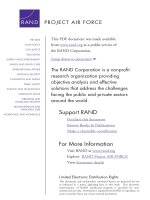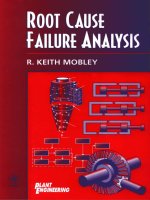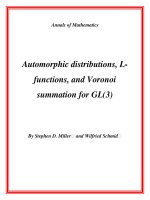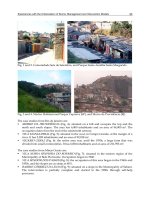Risk Analysis for Engineering 3 pot
Bạn đang xem bản rút gọn của tài liệu. Xem và tải ngay bản đầy đủ của tài liệu tại đây (439.39 KB, 30 trang )
• A. J. Clark School of Engineering •Department of Civil and Environmental Engineering
CHAPTER
3a
CHAPMAN
HALL/CRC
Risk Analysis in Engineering and Economics
Risk Analysis for Engineering
Department of Civil and Environmental Engineering
University of Maryland, College Park
SYSTEM DEFINITION AND
STRUCTURE
CHAPTER 3a. SYSTEM DEFINITION AND STRUCTURE
Slide No. 1
Introduction
̈ Definition of the problem at hand is
necessary for risk analysis.
̈ The definition and structuring of the
problem requires skill.
̈ Risk must be assessed, analyzed, and
managed within the system framework with
the objective optimum utilization of
available resources and for the purpose of
maximizing the benefits.
CHAPTER 3a. SYSTEM DEFINITION AND STRUCTURE
Slide No. 2
Introduction
̈ Some Requirements for risk Analysis and
Management:
– The structure must be within a systems
framework.
– The approach must be systematic and must
capture all critical aspects of the problem.
– Uncertainties must be assessed and
considered.
– An optimization scheme of the utilization of
available resources should be constructed.
CHAPTER 3a. SYSTEM DEFINITION AND STRUCTURE
Slide No. 3
System Definition Models
̈ Perspectives for System Definition
Greek word
systma
system
Meaning an organized whole
CHAPTER 3a. SYSTEM DEFINITION AND STRUCTURE
Slide No. 4
System Definition Models
̈ Perspectives for System Definition (cont’d)
– According to the Webster’s dictionary, a
system is defined as “a regularly interacting or
interdependent group of items forming a
unified whole.”
– Also, it is defined as “a set or arrangement of
things so related or connected as to form a
unity or organic whole,”.
– Examples:
• solar system
• school system
• system of highways
CHAPTER 3a. SYSTEM DEFINITION AND STRUCTURE
Slide No. 5
System Definition Models
̈ Perspectives for System Definition (cont’d)
– System Science: is usually associated with
observations, identification, description,
experimental investigation, and theoretical
modeling and explanations that are associated
with natural phenomena in fields, such as
biology, chemistry and physics.
– System analysis: includes ongoing analytical
processes of evaluating various alternatives in
design and model construction by employing
mathematical methods.
CHAPTER 3a. SYSTEM DEFINITION AND STRUCTURE
Slide No. 6
System Definition Models
̈ Perspectives for System Definition (cont’d)
• Example of Mathematical Methods
– Optimization
– reliability assessment
– Statistics
– risk analysis
– operations research
– For scientists and engineers, the definition of a
system can be stated as “a regularly
interacting or interdependent group of items
forming a unified whole that has some
attributes of interest.”
CHAPTER 3a. SYSTEM DEFINITION AND STRUCTURE
Slide No. 7
System Definition Models
̈ Perspectives for System Definition (cont’d)
– The discipline of systems engineering
establishes the configuration and size of system
• Hardware
• Software
• Facilities
• Personnel
through an interactive process of analysis and
design in order to satisfy an operational mission
for the system to perform in a cost-effective
manner.
CHAPTER 3a. SYSTEM DEFINITION AND STRUCTURE
Slide No. 8
System Definition Models
̈ Perspectives for System Definition (cont’d)
– Identification of needs by systems engineers
System-based
Formulation of
Engineering
Problems
People
Development
of Solutions
Definition
of Needs
Environment
Figure 1. Engineers and Systems
CHAPTER 3a. SYSTEM DEFINITION AND STRUCTURE
Slide No. 9
System Definition Models
̈ Perspectives for System Definition
(cont’d)
– Systems can be grouped in various
categories such as
1. natural systems, such as river systems, and
energy systems;
2. human-made systems that can be imbedded in
the natural systems, such as hydroelectric power
systems and navigation systems;
3. physical systems that are made of real
components occupying space, such as,
automobiles and computers;
CHAPTER 3a. SYSTEM DEFINITION AND STRUCTURE
Slide No. 10
System Definition Models
4. conceptual systems that could lead to physical
systems;
5. static systems that are without any activity, such
as, bridges subjected to dead loads;
6. dynamic systems, such as, transportation
systems; and
7. closed or open-loop systems, such as, a chemical
equilibrium process and logistic systems,
respectively.
CHAPTER 3a. SYSTEM DEFINITION AND STRUCTURE
Slide No. 11
System Definition Models
̈ Example 1: Safety of Flood-Control Dams
Figure 2. Flooded Dam, Lacamas Lake Dam, Camas, WA, 1996
CHAPTER 3a. SYSTEM DEFINITION AND STRUCTURE
Slide No. 12
System Definition Models
̈ Example 1: Safety of Flood-
Control Dams (cont’d)
– The primary purposes of most
flood-control dams are flood
control and grade stabilization.
– A secondary function is
trapping sediment.
– Flood-control dams are
designed and constructed for
a sufficient capacity to store
runoffs from a ten- to hundred-
year storm.
CHAPTER 3a. SYSTEM DEFINITION AND STRUCTURE
Slide No. 13
System Definition Models
̈ Example 1: Safety of Flood-Control Dams
(cont’d)
Figure 3. Dam Failure, Centralia, WA, 1996
CHAPTER 3a. SYSTEM DEFINITION AND STRUCTURE
Slide No. 14
System Definition Models
̈ Example 1: Safety of Flood-
Control Dams (cont’d)
– The safety assessment of a dam
requires defining a dam system to
include
1. The dam facility of structures,
foundations, spillways, equipment,
warning systems, and personnel,
2. The upstream environment that can
produce storms and floods, and
3. The downstream environment that
includes the potential sources of
flood consequences.
CHAPTER 3a. SYSTEM DEFINITION AND STRUCTURE
Slide No. 15
System Definition Models
̈ Requirements Analysis and Work
Breakdown Structure
– Requirements Analysis
• Requirements analysis can be defined as the
detailed study of the system's performance
requirements to ensure that the completed system
achieves its intend utility to the customer and
meets the goal stated.
• According to this method, the customer's needs
should be determined, evaluated for their
completeness, and translated into quantifiable,
verifiable, and documented performance
requirements.
CHAPTER 3a. SYSTEM DEFINITION AND STRUCTURE
Slide No. 16
System Definition Models
̈ Requirements Analysis and Work
Breakdown Structure (cont’d)
– Requirements Analysis (cont’d)
• Requirements analysis feeds directly into functional
analysis, and allocation, design and synthesis.
• A system model can be developed through
requirement and functional modeling.
• For example, dams can be modeled as systems
with functional and performance requirements in an
environment that has natural and human-made
hazards.
CHAPTER 3a. SYSTEM DEFINITION AND STRUCTURE
Slide No. 17
System Definition Models
̈ Requirements Analysis and Work
Breakdown Structure (cont’d)
– Requirements Analysis (cont’d)
• Limiting the model to only the physical system of a
dam is shown in Fig. 4.
• The functional requirements of a dam are used to
develop a system breakdown.
• The system breakdown structure is the top-down
hierarchical division of the dam into its subsystems
and components, including people, structure,
foundation, floodplain, the river and its tributaries,
procedures, and equipment.
CHAPTER 3a. SYSTEM DEFINITION AND STRUCTURE
Slide No. 18
System Definition Models
Dam
Serviceability
Requirements
Safety Requirements
Water
Release
Pool Water
Level
Flood ControlStrength
Stability
Structural/
Geotechnical
Integrity
Downstream
Dams
Flood Plain
Figure 4. Functional Requirements for a Dam
CHAPTER 3a. SYSTEM DEFINITION AND STRUCTURE
Slide No. 19
System Definition Models
̈ Requirements Analysis and Work
Breakdown Structure (cont’d)
– Requirements Analysis (cont’d)
• Functional analysis examines the characteristic
actions of hardware, software, facilities, or
personnel that are needed for the system in order
to satisfy performance requirements of the system.
• Functional analysis might establish additional
requirements on all supporting elements of the
system by examining their detailed operations and
interactions.
CHAPTER 3a. SYSTEM DEFINITION AND STRUCTURE
Slide No. 20
System Definition Models
̈ Requirements Analysis and Work
Breakdown Structure (cont’d)
– Requirements Analysis (cont’d)
• Physical requirements define the system's physical
nature, such as mass, volume, power, throughput,
memory, and momentum.
• They may also include details down to type and
color of paint, location of the ground segment
equipment, and specific environmental protection.
CHAPTER 3a. SYSTEM DEFINITION AND STRUCTURE
Slide No. 21
System Definition Models
̈ Requirements Analysis and Work
Breakdown Structure (cont’d)
– Requirements Analysis (cont’d)
• Functional requirements can be loosely assembled
into hierarchy of functional, sequential,
communicational, procedural, temporal, and logical
attributes as follows:
– Functional requirements with subfunctions that contribute
directly to performing a single function.
– Sequential breakdowns that show data flow processed
sequentially from input to output.
– Communicational breakdown based on information and
data needs.
CHAPTER 3a. SYSTEM DEFINITION AND STRUCTURE
Slide No. 22
System Definition Models
– Procedural breakdowns based on logic flow paths.
– Temporal breakdowns for differing functions at different
times.
– Logical breakdowns based on developing logical flows for
functions.
• Many programs develop multiple functional
hierarchies using more than one of these criteria to
sort and decompose the functions.
• Each criterion provides a different way of looking at
the information.
• The most common functional hierarchy is a
decomposition based on functional grouping.
CHAPTER 3a. SYSTEM DEFINITION AND STRUCTURE
Slide No. 23
System Definition Models
̈ Requirements Analysis and Work
Breakdown Structure (cont’d)
– Work Breakdown Structure
• The work breakdown structure is a physical-
oriented family tree composed of
– Hardware
– Software
–Services
– Processes
– Data that result from engineering efforts during the design
and development of a system.
CHAPTER 3a. SYSTEM DEFINITION AND STRUCTURE
Slide No. 24
System Definition Models
Dam System
Dam Facility
Downstream and
Water Outflow
Dam Foundation
Dam
Structure
Downstream
Dams
Flood Plain
Property
Environment
Wildlife
Lifelines
Upstream and
Water Inflow
Drainage Basin
Precipitation
Soil Moisture
Snow and Ice
River,
Tributaries,
and other
Water Bodies
Upstream
Dams
Vegetation
Adjacent to
Water Bodies
Earth
Adjacent to
Water Bodies
Slides Debris
TurbinesSpillway
Outlet Gates
Flood Warning
Equipment
CapacityInitial Level
Reservoir
Seismic
History and
Faults
Vegetation
Soil
Population
Figure 5. Work Breakdown Structure for a Dam
CHAPTER 3a. SYSTEM DEFINITION AND STRUCTURE
Slide No. 25
System Definition Models
̈ Contributing Factor Diagrams
– The contributing factor diagrams are used to
identify variables and their dependencies that
can be used to analytically evaluate quantities,
called
answer variables
, selected by a risk
analyst to define a risk problem.
– A contributing factor diagram consists of
variables graphically enclosed in
•Ovals
•Circles
• Rectangles
connected by directed arrows.
CHAPTER 3a. SYSTEM DEFINITION AND STRUCTURE
Slide No. 26
Basic Variables
System Definition Models
̈ Contributing Factor Diagrams (cont’d)
– Construction of a Contributing Factor Diagram
Answer Variables
CHAPTER 3a. SYSTEM DEFINITION AND STRUCTURE
Slide No. 27
System Definition Models
̈ Contributing Factor Diagrams (cont’d)
Construction of a Contributing Factor Diagram:
1. Identify and select answer variables in
consultation with stakeholders and specialists in
various areas. Commonly, economic answer
variables are selected such as the net present
value (NPV) or internal rate of return defined in a
subsequent section. This step can be difficult
resulting in to several answer variables. These
variables should be placed at the center of the
diagram in oval shapes.
CHAPTER 3a. SYSTEM DEFINITION AND STRUCTURE
Slide No. 28
System Definition Models
Construction of a Contributing Factor
Diagram (cont’d):
2. Select the units of measurement for the answer
variables, such as dollars per year, or tons per
year.
3. Identify and select primary contributing variables
to the answers variables. For example income
and cost variables can be used with directed
arrows feeding from them to the answer
variable(s). For each variable, the units of
measurement should be identified. Quantitative
models are needed to express the dependencies
among the variables.
CHAPTER 3a. SYSTEM DEFINITION AND STRUCTURE
Slide No. 29
System Definition Models
Construction of a Contributing Factor
Diagram (cont’d):
4. Define lower level variables that feed into
previously defined variables and their units.
5. Repeat step 4 until sufficient refinement is
established as needed for data collection or as
defined by data availability.
These steps are presented in general terms to
permit their use to solve various problems
CHAPTER 3a. SYSTEM DEFINITION AND STRUCTURE
Slide No. 30
System Definition Models
̈ Example 2: Replacement of a Highway
Bridge
– This bridge replacement need might result
from structural (i.e., strength) or functional
deficiencies.
– This decision situation requires the
development of an economic model to assess
the annual benefit to replace an existing
bridge with a new one.
CHAPTER 3a. SYSTEM DEFINITION AND STRUCTURE
Slide No. 31
System Definition Models
̈ Example 2: Replacement of a Highway
Bridge (cont’d)
– Figure 6 provides a contributing factor diagram
for such a decision situation.
– The answer variable in this case was identified
as the average annual benefit of replacing the
bridge in dollars per year.
– This variable was placed in the middle of the
figure, and was used as the starting point to
develop this figure.
CHAPTER 3a. SYSTEM DEFINITION AND STRUCTURE
Slide No. 32
Average annual benefit
of replacing a bridge
($/yr)
Existing bridge
New bridge
Life of new bridge
(yrs)
Age of existing
bridge (yrs)
Present value of
additional life ($)
Annual operation and
maintenance cost for
existing bridge ($/yr)
Annual operation and
maintenance cost for new
bridge ($/yr)
Annual operation and
maintenance savings
($/yr)
Life extension of bridge
functionality (yrs)
Cost of new bridge
Discount rate
Present value of
Expected failure cost for
new bridge ($/yr)
Failure likelihood for
new bridge
Failure consequences
for new bridge
Annual failure cost
savings for existing
bridge ($/yr)
Present value of
Expected failure cost for
existing bridge ($/yr)
Failure likelihood for
existing bridge
Failure consequences
for existing bridge
Risk Analysis
Figure 6. Contributing Factors for Risk-
Based Replacement of an
Existing Bridge
CHAPTER 3a. SYSTEM DEFINITION AND STRUCTURE
Slide No. 33
System Definition Models
̈ Example 2: Replacement of a Highway
Bridge (cont’d)
Three primary computational tracks are
required:
1. the annual benefit generated by an extended
bridge functionality beyond the age of an existing
bridge with an added life provided by a new
bridge;
2. annual benefit of reduced operation and
maintenance cost; and
3. annual benefit of reduced expected failure cost.
CHAPTER 3a. SYSTEM DEFINITION AND STRUCTURE
Slide No. 34
System Definition Models
̈ Decision Trees and Influence Diagrams
– Decision Trees
• One graphical tool for performing an organized
decision analysis is a decision tree.
• A decision tree is constructed by showing the
alternatives for decision-making and associated
uncertainties.
• The result of choosing one of the alternative paths
in the decision tree is the consequences of the
decision.
CHAPTER 3a. SYSTEM DEFINITION AND STRUCTURE
Slide No. 35
System Definition Models
̈ Decision Trees and Influence Diagrams
– The construction of a decision model requires
the definition of
• objectives of decision analysis,
• decision variables,
• decision outcomes, and
• associated probabilities and consequences.
– The boundaries for the problem can be
determined from first understanding the
objectives of the decision-making process and
using them to define the system.
CHAPTER 3a. SYSTEM DEFINITION AND STRUCTURE
Slide No. 36
System Definition Models
̈ Decision Trees and Influence Diagrams
– Decision Variables
• The decision variables for the decision model need
to be defined.
• Ranges of values that can be taken by the decision
variables should be defined.
• Example: Mechanical or Structural Components
– what and when to inspect components or equipment.
– which inspection methods to use, assessing the
significance of detected damage.
– repair/replace decisions.
CHAPTER 3a. SYSTEM DEFINITION AND STRUCTURE
Slide No. 37
System Definition Models
Question
Symbol
Decision Node: indicates where a decision must be
made.
Definition
Question
Chance Node: represents a probabilistic or random variable.
Deterministic Node: determined from the inputs from other nodes.
Value Node: defines consequences over the attributes
measuring performance.
Arrow/Arc: denotes influence among nodes.
Indicates time sequencing (information that must be
known prior to a decision).
Indicates probabilistic dependence upon the decision or
uncertainty of the previous node.
Figure 7. Symbols for Influence
Diagrams and Decision
Trees
CHAPTER 3a. SYSTEM DEFINITION AND STRUCTURE
Slide No. 38
System Definition Models
̈ Decision Trees and Influence Diagrams
– Decision Outcomes
• The decision outcomes are the events that can
happen as a result of a decision.
• They are random in nature, and their occurrence
cannot be fully controlled by the decision maker.
• Decision outcomes can include:
– the outcomes of an inspection (detection or non-detection
of a damage), and
– the outcomes of a repair (satisfactory or non-satisfactory
repair).
CHAPTER 3a. SYSTEM DEFINITION AND STRUCTURE
Slide No. 39
System Definition Models
̈ Decision Trees and Influence Diagrams
– Decision Outcomes (cont’d)
• Therefore, the decision outcomes with the
associated occurrence probabilities need to be
defined.
• The decision outcomes can occur after making a
decision at points within the decision-making
process called chance nodes.
• The chance nodes are identified in the model using
a circle as shown in Figure 7.
CHAPTER 3a. SYSTEM DEFINITION AND STRUCTURE
Slide No. 40
System Definition Models
̈ Decision Trees and Influence Diagrams
– Associated Probabilities and
Consequences
• The decision outcomes take values that can have
associated probabilities and consequences.
• The probabilities are needed due to the random
(chance) nature of these outcomes.
• The consequences can include, for example, the
cost of failure due to damage that was not detected
by an inspection method.
CHAPTER 3a. SYSTEM DEFINITION AND STRUCTURE
Slide No. 41
System Definition Models
̈ Decision Trees and Influence Diagrams
– Tree Construction
• The decision tree includes the decision and chance
nodes.
• The decision nodes, that are represented by
squares in a decision tree, are followed by possible
actions (or alternatives, A
i
) that can be selected by
a decision maker.
• The chance nodes, that are represented by circles
in a decision tree, are followed by outcomes that
can occur without the complete control of the
decision maker.
CHAPTER 3a. SYSTEM DEFINITION AND STRUCTURE
Slide No. 42
System Definition Models
̈ Decision Trees and Influence Diagrams
– Tree Construction (cont’d)
• Outcomes have both probabilities (P) and
consequences (C).
• Here the consequence can be cost.
• Each tree segment followed from the beginning (left
end) of the tree to the end (right end) of the tree is
called a branch.
• Each branch represents a possible scenario of
decisions and possible outcomes.
• The total expected consequence (cost) for each
branch could be computed.
CHAPTER 3a. SYSTEM DEFINITION AND STRUCTURE
Slide No. 43
System Definition Models
• Then the most suitable decisions can be selected
to obtain the minimum cost.
• In general, utility values can be used and
maximized instead of cost values. Also, decisions
can be based on risk profiles by considering both
the total expected utility value and the standard
deviation of the utility value for each alternative.
• The standard deviation can be critical for decision-
making as it provides a measure of uncertainty in
utility values of alternatives.
• Influence diagrams can be constructed to model
dependencies among decision variables,
outcomes, and system states using the same
symbols of Figure 7.
CHAPTER 3a. SYSTEM DEFINITION AND STRUCTURE
Slide No. 44
System Definition Models
̈ Example 3: Decision Analysis for Selecting
an Inspection Strategy
Inspect
butt Welds
A1: Visual Inspection
A2: Dye Penetrant Test
A4: Ultrasonic Test
A3: Magnetic Particle Test
C(A1): $0.5/foot
C(A2): $1.0/foot
C(A3): $4.0/foot
C(A4): $15.0/foot
O1: Detection
P(O1)=0.25, C(O1) = $10/foot
O3: Detection
P(O3)=0.4, C(O3) = $10/foot
O5: Detection
P(O5)=0.6, C(O5) = $10/foot
O7: Detection
P(O7)=0.7, C(O7) = $10/foot
O2: Non-detection
P(O2)=0.75, C(O2) = $50/foot
O4: Non-detection
P(O4)=0.6, C(O4) = $50/foot
O6: Non-detection
P(O6)=0.4, C(O6) = $50/foot
O8: Non-detection
P(O8)=0.3, C(O8) = $50/foot
Branch Cost
C(A1)+P(O1)*C(O1)+P(O2)*C(O2)
=$40.5/foot
C(A2)+P(O3)*C(O3)+P(O4)*C(O4)
=$35.0/foot
C(A3)+P(O5)*C(O5)+P(O6)*C(O6)
=$30.0/foot
C(A4)+P(O7)*C(O7)+P(O8)*C(O8)
=$37.0/foot
= Decision node
= Chance node
A = Alternative
O = Outcome
P( ) = Probability
C( ) = Cost of ( )
Figure 8. Decision Tree for Weld Inspection Strategy
CHAPTER 3a. SYSTEM DEFINITION AND STRUCTURE
Slide No. 45
System Definition Models
̈ Example 4: Decision Analysis for Selection of a Personal
Flotation Devise Type
Select PFD
Type
A1: Type 1
Inherently Buoyant
A2: Type 1
Inflatable
A3: Other Proposal
Effectiveness (E)
Reliable (R)
Overall Probability of
Combined Effectiveness &
Reliability
P (E)
P (E)
P (E)
P (E)
P (E)
P (E)
P(R)
P (R)
P (R)
P (R)
P (R)
P (R)
P (R)
P (R)
P (R)
P (R)
P (R)
Decision
Node
Chance Node
P( ) = Probability
A = Alternative
E = Effective
E = Not Effective
R = Not Reliable
R = Reliable
P (R)
For A1: P(E) P(R)
For A2: P(E) P(R)
For A3: P(E) P(R)
Figure 9. Selecting a Personal Flotation Devise (PFD)
Based on Effectiveness and Reliability
CHAPTER 3a. SYSTEM DEFINITION AND STRUCTURE
Slide No. 46
System Definition Models
̈ Decision Trees and Influence Diagrams
– Influence Diagrams
• An influence diagram is a graphical tool that shows
the dependence relationships among the decision
elements of a system.
• Influence diagrams are of similar objectives to
contributing factor diagrams, but with more details.
• Influence diagrams provide compact
representations of large decision problems by
focusing on dependencies among various decision
variables.
CHAPTER 3a. SYSTEM DEFINITION AND STRUCTURE
Slide No. 47
System Definition Models
̈ Decision Trees and Influence Diagrams
– Influence Diagrams
• Influence diagrams consist of
– decision nodes,
– chance nodes,
– outcomes, and
– directed arrows indicating dependencies.
• Symbols used for creating influence diagrams are
shown in Figure 7
• The fist
rectangular shape in the figure is used to
identify a decision node that indicates where a
decision must be made.
CHAPTER 3a. SYSTEM DEFINITION AND STRUCTURE
Slide No. 48
System Definition Models
Question
Symbol
Decision Node: indicates where a decision must be
made.
Definition
Question
Chance Node: represents a probabilistic or random variable.
Deterministic Node: determined from the inputs from other nodes.
Value Node: defines consequences over the attributes
measuring performance.
Arrow/Arc: denotes influence among nodes.
Indicates time sequencing (information that must be
known prior to a decision).
Indicates probabilistic dependence upon the decision or
uncertainty of the previous node.
Figure 7. Symbols for Influence
Diagrams and Decision
Trees
CHAPTER 3a. SYSTEM DEFINITION AND STRUCTURE
Slide No. 49
System Definition Models
•A circular or elliptical shape is used to identify a
chance node representing a probabilistic random
variable with uncertain outcomes.
• The
double circles or ellipses are used to identify
a deterministic node with a quantity in it that is
determined from the inputs from other nodes.
• The
pentagon shape is called a value node and is
used to defines consequences over the attributes
measuring performance.
• The next two symbols showing
arrows or arcs that
are used to represent influence or dependency
among nodes.
• The last rectangular shape is used top indicate
time sequencing, i.e., information that must be
known prior to a decision









